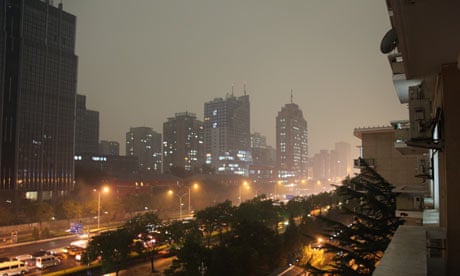A 2C rise in global temperatures will not necessarily result in the calamity predicted by the Intergovernmental Panel on Climate Change (IPCC), China's most senior climatologist has told the Guardian.
Despite growing evidence that storms in China are getting fiercer, droughts longer and typhoons more deadly, Xiao Ziniu, the director general of the Beijing Climate Centre, said it was too early to determine the level of risk posed by global warming.
"There is no agreed conclusion about how much change is dangerous," Xiao said. "Whether the climate turns warmer or cooler, there are both positive and negative effects. We are not focusing on what will happen with a one degree or two degree increase, we are looking at what level will be a danger to the environment. In Chinese history, there have been many periods warmer than today."
The IPCC warns a 2C rise substantially increases the risks of floods, drought and storms.
Whether a 2C rise turns global warming into global burning has emerged as one of the most contentious issues in advance of the Copenhagen summit.
The G8 and EU want the world to set 2C as a ceiling by 2050, but China is sceptical. A senior government adviser said yesterday that the target of two degrees was unrealistic and would not give developing nations room to grow.
Xiao said China had started its own climate modelling programme for the next 100 years aimed at predicting the point when global warming will result in environmental collapse.
His centre will also release yearly climate predictions for China. Even with weather satellites and sophisticated simulation software, Xiao is not overly optimistic about accuracy the initial results.
"Climate prediction has only come into operation in recent years. The accuracy of the prediction is very low because the climate is affected by many mechanisms we do not fully understand."
China's growing influence in climate studies was recognised this year when the World Meteorological Organisation selected Beijing as a co-host of the Asian Climate Centre. Alongside Tokyo, it will be responsible for monitoring and predicting changes in weather patterns and their impact on natural disasters, water resources and soil quality.
Even at current levels of warming, the centre has collected a strong body of evidence that climate change is wreaking havoc in China.
A report provided by the centre to the Guardian shows rainfall coming in shorter, fiercer bursts, interspersed by protracted periods of drought, particularly in the north. Water supplies have been badly affected. The Yellow river watershed has suffered a continuous drought since 1965 and it is getting worse, it said. Almost half the serious droughts of the past 60 years have occurred since 1990.
"Due to climate change, drought disasters come more frequently and across a wider area," the report noted.
Since 1950, Beijing has had an average of 36 rainy days a year, but not once in the past decade has that figure been reached. In 2007, the northernmost province of Heilongjiang reported a summer drought, which is almost unheard of in what is usually a flood season. Glaciers are melting at an accelerating rate.
A ferocious storm on 10 May this year broke records in Gaoqing, Shandong, with nearly 19.7cm of water dumped from the skies in one day. On the edge of the Gobi desert in Xilin Haote, Inner Mongolia, 5.6 cm of rain fell on 27 June 2008 – the most since a monitoring station was established in the area fifty years earlier.
Summer is coming earlier and hotter across swaths of the North. Of the many records broken this year, the most dramatic was in Shijiazhuang Hebei where the temperature soared to 30C on 17 March, more than six degrees higher than the previous high for that day.
Near the border with Siberia, the counties of Yilan and Yichun have experienced the hottest May in history and searing heat of more than 40C is now commonplace in many areas of the north.
"I think it is the responsibility of scientists to have a sense of crisis. We should study whether climate change threatens human survival," says Xiao. "But I believe humans are wise creatures. With wisdom and effort, we will prevent disaster. There is always hope."
Founded in 1995 as a national level organisation, the centre's 150 staff compile data from four Chinese weather satellites, thousands of national monitoring stations and a regional network of meteorological organisations.

Comments (…)
Sign in or create your Guardian account to join the discussion